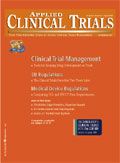eShowcase
Tools for Clinical Trials Professionals
Software digitizes the entire clinical trial source and lifecycle management process
Oracle (Redwood Shores, CA) recently announced the integration of DrugLogic Qscan with its Adverse Event Reporting System (AERS) tool. The combined solutions offer a risk management architecture that leverages advanced analytics to help companies streamline compliance with pharmacovigilance requirements.
As a result of this integration, AERS pharmacovigilance users can visualize their case data in Qscan right away and focus on the case of most interest. Drug safety teams can also set minimums for automatically detecting safety signals and receiving alerts when thresholds are reached or exceeded.

Oracle Adverse Event Reporting System
Oracle AERS features a query-by-example module that allows users to mine data with multiple case data elements. They can perform queries using advanced dictionary relationships, or return data based on Standardized MeDRA Queries. And with the new Qscan component, users can immediately investigate adverse event data against public data sources.
Oracle, (650) 506-7000, www.oracle.com
EDC tool now boasts barcode scanning capabilities without the hassle of software installation
TrialStat Corporation (Ottawa, ON) announced enhancements to their ClinicalAnalytics 3.0 (CA3) handheld electronic data capture technology at the DIA Meeting in June. Now, CA3 features barcode scanning capabilities, allowing researchers using handheld wireless devices with barcode scanners to capture information directly into electronic forms. They can identify such items as case report forms, subjects via wrist bands, and laboratory and pharmaceutical materials. This feature requires no additional programming or configuration.

TrialStat ClinicalAnalytics 3.0
CA3 is available as a Web-based service that offers integrated support for disconnected devices. Since CA3 is a hosted tool, there is no software to install at clinical research sites. Additional features include image-based data capture, customizable dashboards and coding dictionaries, easy-to-use audit trail, automatic Word and PDF documentation, randomization, real-time form validation, and a patient self-reporting tool.
TrialStat Corporation, (613) 741-9909, www.trialstat.com
Newest version automatically migrates data between CRFs when mid-study changes occur
Phoenix Data Systems (PDS; Philadelphia, PA) announced the release of Express 4 in June. The software is an update to PDS's EDC application designed to help life science companies capture, clean, and manage data throughout all clinical trial phases.
Express 4 uses the .Net framework to enable interaction between internal and remote systems. This results in streamlined deployment, enhanced interoperability with diverse systems, and improved update capability. A useful feature of Express 4 is seamless CRF version management, which lets existing subject data from one CRF version migrate to another in the event of mid-study changes.

Phoenix Data Systems Express 4
The suite also features the PDS AutoEncoder, a medical dictionary tool that streamlines coding (data management services are also available if a client wants to code manually) plus improved reporting and forms marking.
Phoenix Data Systems, (484) 928-6000, www.phoenixdatasystems.net

Behind the Buzz: Why Clinical Research Leaders Flock to SCOPE Summit
February 7th 2025In this episode, we meet with Micah Lieberman, Executive Conference Director for SCOPE Summit (Summit for Clinical Ops Executives) at Cambridge Innovation Institute. We will dive deep into the critical role of collaboration within the clinical research ecosystem. How do we bring together diverse stakeholders—sponsors, CROs, clinical trial tech innovators, suppliers, patients, sites, advocacy organizations, investors, and non-profits—to share best practices in trial design, program planning, innovation, and clinical operations? We’ll explore why it’s vital for thought leaders to step beyond their own organizations and learn from others, exchanging ideas that drive advancements in clinical research. Additionally, we’ll discuss the pivotal role of scientific conferences like SCOPE Summit in fostering these essential connections and collaborations, helping shape the future of clinical trials. Join us as we uncover how collective wisdom and cross-industry partnerships are transforming the landscape of clinical research.
Reaching Diverse Patient Populations With Personalized Treatment Methods
January 20th 2025Daejin Abidoye, head of solid tumors, oncology development, AbbVie, discusses a number of topics around diversity in clinical research including industry’s greatest challenges in reaching diverse patient populations, personalized treatment methods, recruitment strategies, and more.